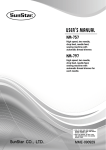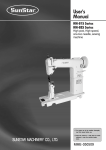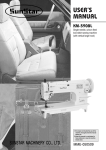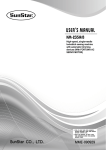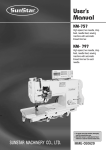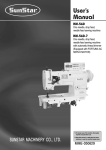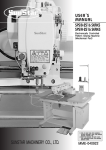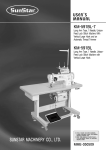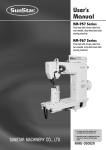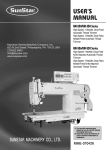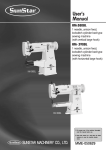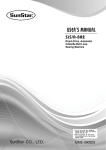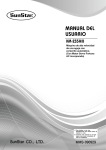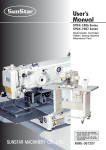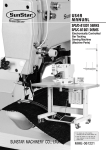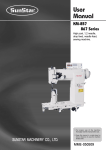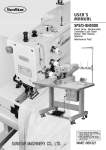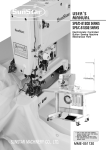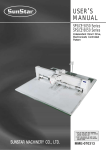Download User`s Manual
Transcript
R User’s Manual KM-570BL 1 needle, drop feed, needle feed sewing machine KM-570BL-7 1 needle, drop feed, needle feed sewing machine with automatic thread trimmer KM-572BL 2 needle, drop feed, needle feed sewing machine KM-572BL-7 2 needle, drop feed, needle feed sewing machine with automatic thread trimmer 1) For proper use of the machine, thoroughly read this manual before use. SUNSTAR MACHINERY CO., LTD. 2) Keep this manual in a safe place for future reference in case the machine breaks down. MME-060710 lity a u tQ Besst Pricevice Be st Ser Be 1. Thank you for purchasing our product. Based on the rich expertise and experience accumulated in industrial sewing machine production, SUNSTAR will manufacture industrial sewing machines, which deliver more diverse functions, high performance, powerful operation, enhanced durability, and more sophisticated design to meet a number of user’s needs. 2. Please read this user’s manual thoroughly before using the machine. Make sure to properly use the machine to enjoy its full performance. 3. The specifications of the machine are subject to change, aimed to enhance product performance, without prior notice. 4. This product is designed, manufactured, and sold as an industrial sewing machine. It should not be used for other than industrial purpose. R SUNSTAR MACHINERY CO., LTD. Table of contents Safety Rules for Machine .......................................................................................................................................... 4 1. Specification ............................................................................................................................................................... 8 1) Sewing machine ............................................................................................................................................................. 8 2) Motor .............................................................................................................................................................................. 8 3) Peripheral automation devices (optional) ..................................................................................................................... 8 2. Installation ................................................................................................................................................................... 9 1) Installation of machine head ......................................................................................................................................... 9 2) Installation of power switch box ................................................................................................................................... 9 3) Oil supply ..................................................................................................................................................................... 10 4) Belt tension adjustment ............................................................................................................................................... 10 5) Installation of program unit (Trimmer Type) .............................................................................................................. 11 6) Installation of belt cover .............................................................................................................................................. 11 7) Installation of thread stand .......................................................................................................................................... 11 8) Installation of knee lifting pad .................................................................................................................................... 12 9) Installation of air pressure related parts and checking their functions (optional) ..................................................... 12 3. Adjustment of the Machine ............................................................................................................................. 13 1) Inserting the needle ...................................................................................................................................................... 13 2) Removing bobbin ........................................................................................................................................................ 13 3) Winding the lower thread ............................................................................................................................................ 14 4) Routing the upper thread ............................................................................................................................................. 14 5) Adjusting the thread tension ........................................................................................................................................ 15 6) Adjusting the tension of the presser foot .................................................................................................................... 17 7) Stitch length adjustment .............................................................................................................................................. 17 8) Adjusting timing of needle and hook .......................................................................................................................... 17 9) Clearance adjustment between hook and opener ....................................................................................................... 18 10) Adjusting feed dog height ......................................................................................................................................... 19 11) Adjusting the auxiliary presser foot and the upper feed presser foot ...................................................................... 19 12) Adjusting timing of the auxiliary presser foot, the upper feed foot and the needle ................................................ 21 13) Adjusting stroke of upper feed presser foot .............................................................................................................. 21 14) Adjusting safety device ............................................................................................................................................. 22 15) Adjusting the trimming device .................................................................................................................................. 22 16) Adjustment of Thread Release .................................................................................................................................. 25 17) Installation of Automatic Lap Lifting Device (optional) ......................................................................................... 25 4. Causes of Troubles and Troubleshooting ............................................................................................... 27 1) Sewing machine troubleshooting ................................................................................................................................ 27 5. Table drawing ......................................................................................................................................................... 29 Safety Rules for Machine Safety labels in the manual are categorized into danger, warning and caution. Failure to follow the safety rules may result in physical injuries or mechanical damages. The safety labels and symbols are defined as follows. [The meaning of the safety labels] Danger Danger Instructions here shall be observed strictly. Otherwise, the user will be killed or suffer severe physical injuries Warning Warning Instructions here must be observed, or the user could suffer fatal or severe physical injuries. Caution Caution Instructions here should be observed, or the user could face physical injuries or mechanical damages. [The meaning of symbols] This symbol means a must-not. This symbol means a must for safety. This symbol means that an electric shock may be caused if the instruction is not followed properly. 4 1-1) Machine mobilization Only personnel with a full understanding of the safety rules should move the machines. The following directions must be observed when delivering the machines. ⓐ At least two persons should work together. ⓑ In case the machine should be transported, please wipe the oil covered on the machine to prevent accidents Danger 1-2) Machine Installation Caution Because physical damage such as the functional obstacles and breakdowns are likely to occur according to the environment in which the machine is being installed. Therefore, the following preconditions should be fulfilled. ⓐ Please keep the order from top to bottom when unpacking the package. Especially, mind that the nail on the boxes. ⓑ Because machines are apt to be contaminated and corroded by dust and moisture, you should install the climate controller and should clean the machines regularly. ⓒ Keep the machines out of the direct rays of the sun. ⓓ Keep both sides and the backside of the machines off at least 50cm from the wall to secure enough space to repair. ⓔ Don’ t run the machine near the places with the dangers of explosion. Don’t run the machine near the places with the dangers of explosion, including the places where the spraying product like aerosol are used in large quantities or oxygen are dealt with, unless the exact actions concerning the operation are guaranteed to avoid the explosion. ⓕ Because of the peculiarity of the machine, any illuminators are not equipped. So, users should install the lighting apparatus around the working area. [Note] The details about the installment of the machine are described in No. 2 Installations. 1-3) Troubleshooting Danger In need of troubleshooting, it should be done by the trained A/S engineer of our company. ⓐ Ahead of cleaning and repair, be sure to shut off the power supply. And wait for about 4 minutes till the machine discharges completely. ⓑ Even a part or all of the machine should not be modified without any consultation with our company. ⓒ In case of repair, you should change the damaged part into the standard article of our company. ⓓ After repair, please put again the safety cover disjointed while repairing. 5 1-4) Machine Operation Warning KM-570/572 series are manufactured for industry use to sew textiles and other similar material. In case of running the machine, users should observe the following things. ⓐ Ahead of operating the machine, please read the manual and understand fully the details on its operation. ⓑ Don’t forget to put on the garment suited for the safe work. ⓒ Keep your hands or a part of the body away from the running part of the machine like a needle, hook, thread take-up spring and pulley etc. ⓓ Don’t remove any kind of cover for safety while running the machine. ⓔ Be sure to connect the earthed line. ⓕ Before opening the electric box such as a control box, be sure to shut off the power supply and make sure that the power switch should be put on“off.” ⓖ When threading the needle or before checking after sewing, be sure to stop the machine. ⓗ Don’t switch on the power supply with the foot on the pedal. ⓘ Don’t run the machine when the cooling fan are not running. Be sure to clean the air filter in the control box once a week. ⓙ If possible, keep off from the strong electronic wave like a high frequency welding machine. Warning 1-5) Safety Device Warning Always start the machine with safety covers in place since fingers or hands could be injured or cut off by the belt. Turn off the power switch during check-ups or adjustments. ⓐ Safety Label: Suggestions while running the machine are stated. ⓑ Thread take-up spring cover: the device to prevent the human body from touching the thread take-up spring. ⓒ Belt cover: the device to prevent hands, feet and clothing from getting jammed by the belt. ⓓ Finger guard: the device to prevent fingers from contacting the needle. ⓐ ⓑ ⓒ ⓓ 6 1-6) Position of Caution Mark CAUTION 경 고 “Caution”is attached to the machine for safety. In case of starting to run the machine, read the directions of“Cautions”carefully. [Position of Caution Mark] Do not operate without finger guard and safety devices. Before threading, changing bobbin and needle, cleaning etc. switch off main switch. 손가락 보호대와 안전장치 없이 작동하지 마십시오. 실, 보빈, 바늘교환시나 청소전에는 반드시 주 전원의 스위치를 꺼 주십시오. CAUTION 경 고 Hazardous voltage will cause injury. Be sure to wait at least 360 seconds before opening this cover after turn off main switch and unplug a power cord. 고압 전류에 의해 감전될 수 있으므로 커버를 열 때는 전원을 내리고 전원 플러그를 뽑고 나 서 360초간 기다린 후 여십시오. 1-7) Content of “ Caution” ” Caution CAUTION 경 고 Do not operate without finger guard and safety devices. Before threading, changing bobbin and needle, cleaning etc. switch off main switch. 손가락 보호대와 안전장치 없이 작동하지 마십시오. 실, 보빈, 바늘교환시나 청소전에는 반드시 주전원의 스위치를 꺼주십시오. CAUTION 경 고 Hazardous voltage will cause injury. Be sure to wait at least 360 seconds before opening this cover after turn off main switch and unplug a power cord. 고압 전류에 의해 감전될 수 있으므로 커버를 열 때는 전원을 내리고 전원 플러그를 뽑고 나서 360초간 기다린 후 여십시오. 7 1 Specification 1) Sewing machine Category KM-570BL-7 Purpose Lubrication Method Max. Sewing Speed Max. No. of Stitches Needle Stroke Manual Presser Foot Lap Lift Automatic 16mm (optional) Crossing Between Upper Feed Presser Foot and Supplementary Presser Foot For Heavy Materials (sheet, bags, tents, sofas, etc.) Automatic Lubrication 2,000spm 9mm 36mm 10.5mm 16mm - 16mm (optional) KM-572BL - 2~6mm Hook Needle Automatic Backtacking Device Automatic Trimmer Bed Size Basic Supply Basic Supply Horizontal 2.5x Hook DP×17 #23 (#14~#25) Basic Supply - Basic Supply - - - 568×178mm 1-phase 110/220V, 3-phase 220V Power Supply KM-572BL-7 KM-570BL 1-phase 110/220V, 3-phase 220V/380V 1-phase 110/220V, 3-phase 220V 1-phase 110/220V, 3-phase 220V 2) Motor ① Servo motor controller MODEL VOLT WATT HERTZ SC55-1B 1 Phase 110V 550W 50/60 Hz SC55-1B 1 Phase 220V 550W 50/60 Hz SC55-3B 3 Phase 220V 550W 50/60 Hz MODEL VOLT WATT HERTZ HEC-1706(1 Phase) 110/220V 400W 50/60 Hz HEC-1705(3 Phase) 220/380V 400W 50/60 Hz ② Clutch motor 3) Peripheral automation devices (optional) Optional device Model AUTO KNEE LIFTING SYSTEM 8 Usage When the pedal is placed at reverse step 1, the presser foot is automatically lifted. It is because the machine has employed the pneumatic cylinder structure. PRODUCTION COUNTER SCOUN-1 A counting device which indicates the completed quantity on the program unit panel, including added, subtracted, corrected or remaining quantity along with other performance rates. MATERIAL EDGE SENSOR SEDG-1C SEDG-2C A device that senses the edge or thickness of the sewing material to stop the machine without manual pedaling. Available in two types: SEDG-1C for edge sensing type and SEDG-2C for thickness sensing type. STANDING PEDAL SPDL-1 SPDL-2 An essential device when one person is operating multiple sewing machines. Has different pedals for acceleration, thread trimming, presser foot and ascending pedal. Types consist of SPDL-1 for fixed speed and SPDL-2 for variable speed. 2 Installation Warning ▶ In case of installing the machine, it should be performed by the trained engineer. ▶ In case of wiring work, be sure to leave the work to an expert or an agent. ▶ The machine weight over 42kg. At least 2 persons should carry out the installing work. ▶ Plug in after finishing the installing work. In case the user press on the step by mistake, the machine runs automatically. By doing so, it can cause the physical injuries. ▶ Connect the earthed lines. Imperfection of the connection of the earthed lines gives rise to an electric shock or malfunction. ▶ Set the belt cover on top of the machine. ▶ In case of bending the machine backward or returning to the original condition, be sure to use both hands. If you use only one hand, it causes physical injuries by slipping. 1) Installation of machine head ※ Insert hinge rubber① into the table. As described in“Figure 1”, put the oil pan corner in the middle of the head supporting rubber② and attach the table. After putting the hinge ③ in the bed hole, insert the hinge rubber① and install the sewing machine in the table corner rubber cushion. ③ ① ② ④ [Figure 1] 2) Installation of power switch box When attaching the power switch box①, as shown in “Figure 2”, attach it to lower right corner of the table. ① [Figure 2] 9 Caution ▶ Be sure to plug in after finishing oil supply. If the user press on the step by mistake, the machine runs automatically. By doing so, it can cause the physical injuries. ▶ In case of treating the lubricant, don't bring the lubricant into contact with eyes or the skin. Its contact can cause an inflammation. And don't drink the lubricant. It can cause vomiting or diarrhea. And Keep it out of the reach of the children. ▶ Be sure to run the machine after supplying oil in case you should start to run it for the first time, or in case it has not been used for a long time. 3) Oil supply (1) Fitting the magnet to remove chips (iron powder). Find the magnet for chip removal① in the accessory box and attach it to the oil pan as in “Figure 3.” ※ Do not use the magnet for other purposes. Operating the sewing machine without the magnets may cause malfunction and adverse effects to its durability. (2) Filling the oil pan with lubricants A. Fill the lubricant up to the“H” point. B. You should use the exclusive oil provided by“SUNSTAR” for industrial sewing machines or TELLUS C10” of the Shell company. C. If the oil lever drops to the“L” level, replenish it to the“H” point. D. Change the lubricant once every two weeks. ① [Figure 3] 4) Belt tension adjustment After installing the motor, if you sufficiently loosen the fixed nuts ① and ②, tension in the belt④ will occur naturally because of the weight of the motor③. At this moment, tighten the fixed nut① and use fixed nut ② to fix it firmly. (See figure 4) ④ ② ③ ① [Figure 4] 10 5) Installation of program unit (Trimmer Type) A. Use 4 fixed screws③ to fix the bracket ② on the program unit① B. In the program unit①, use two fixed bolts ④ to tightly fix the assembled brackets②. ③ ① ② ④ [Figure 5] 6) Installation of belt cover A. Set the groove at the bottom of belt cover“A”① to be aligned with the groove of the head of the belt cover supporting screw②, and insert the cover into the groove. Use the belt cover fixing screws ③ (2EA) to fix the cover to the body of the machine. B. Insert the belt cover“B”② into the belt cover“A”① while maintaining the balance. Use the belt cover fixing screws (3EA) to fix the belt covers to the body of the machine. ④ ② ③ ① [Figure 6] 7) Installation of thread stand As shown in“Figure 7”, assemble the thread stand①, insert it in the table hole, and use the fixed nut② and washer③ to fix it. ② ③ ① [Figure 7] 11 8) Installation of knee lifting pad A. Find the lap lifting pad (ass'y) ① in the accessory box and insert it into the shaft of the oil pan's control body ②. B. Loosen bolt ③ and maintain knee-lifting pad in vertical position to tighten it. ① ② ③ [Figure 8] 9) Installation of air pressure related parts and checking their functions (optional) Caution ▶In need of regulating the machine with the switch on or with the air injected, please pay special attention to your safety. ▶Please adjust air pressure to 0.5Mpa. (1) Installation As shown in the figure, after fixing the air pressure filter on the bracket, use the neck screw to fix the bracket on the lower side of the table. (2) Air pressure adjustment a) Adjust the pressure by taking out and lifting the air pressure filter① knob ② . b) After adjusting the air pressure to. 0.49㎫(5㎏f/㎠) turn the knob ② to its original position and the adjustment is over. ② ① [Figure 9] 12 3 Adjustment of the Machine Caution ▶In case of setting the needle, be sure to switch off the power supply. In case the user press on the step by mistake, the machine runs automatically. By doing so, it can cause the physical injuries. ▶In case of using the clutch motor, the motor revolves because of inertia for a while even after switching off the power supply. Be sure to start to work only after the motor comes to a complete stop. 1) Inserting the needle As in Figure 10, while the needle groove① is headed inward, place the upper end of the needle to closely contact the upper stopper hole②, and then fix the needle by using the fixing screw③. ② ③ ③ ① ③ ② [ KM-572 BL ] [ KM-570 BL ] [Figure 10] 2) Removing bobbin Place the needle ① in the highest position. As in Figure 11, open the sliding plate② and erect the hook③ and the bobbin holder④ to separate the bobbin⑤ (see Figure 11). ④ ③ ① ② ⑤ [Figure 11] 13 Caution ▶In case of adjusting the tension of the lower thread, be sure to switch off the power supply. If the users press on the step by mistake, the machine runs automatically. By doing so, it can cause the physical injuries. ▶In case of using the clutch motor, the motor revolves because of inertia for a while even after switching off the power supply. 3) Winding the lower thread Insert the bobbin ② into the hook ①. As seen in Figure 12, insert the thread through part of the hook and pull it out from the end of the lower thread tension adjustment plate ③. And then pull the thread through the clearance ⑤ between the hook ① and opener ④. The adequate length of the pulled-out lower thread on the slide plate is 50 mm. Lower thread About 50 mm ② ① ④ ⑤ ③ [Figure 12] Caution ▶In case of taking up the upper thread, be sure to switch off the power supply. If the users press on the step by mistake, the machine runs automatically. By doing so, it can cause the physical injuries. ▶In case of using the clutch motor, the motor revolves because of inertia for a while. Be sure to start to work only after the motor comes to a complete stop. 4) Routing the upper thread Place the thread take-up lever to the highest position and hang the upper thread as in Figure 13. ※ The adequate length of upper thread extending from the needle hole is 50 mm for initial sewing. 50m m [Figure 13] 14 5) Adjusting the thread tension Upper thread tension is weak (1) Adjusting the thread tension As in Figure 14, turning clockwise the tension adjustment nut ① of the thread tension control assembly makes the upper thread tension stronger and counter clockwise makes it weaker. Upper thread tension is strong Good sewing ① [Figure 14] (2) Adjusting the lower thread tension As in Figure 15, turning the tension adjustment screw ① of the hook clockwise makes the lower thread tension stronger and counterclockwise makes it weaker. ① [Figure 15] (3) Adjusting the tension of thread take up lever spring A) Adjusting the thread take up stroke As in figure 16, loosen the stopper clamp screw ③, and turn the thread take up lever’s spring stopper ① clockwise to make the stroke smaller and counter clockwise to make it bigger. ※ The thread take up stroke is normally 10~14 mm. Bigger ③ ② ② Smaller [Figure 16] 15 B) Adjusting the thread take up tension As in figure 17, loosen the screw ② of the thread tension control assembly, and insert the driver into the groove of the thread tension control assembly ③. Turn clockwise to make the spring ① tension stronger and counter clockwise to make it weaker. (See Figure 17) ③ Strong Weak ② ① [Figure 17] C) Adjusting the timing of the thread take up spring tension As in Figure 18, loosen the stopper screw ①, and turn clockwise the guide plate ③ for the thread take up spring to make the timing of the spring ② faster and counter clockwise to make it slower. ※ The timing of the thread take up spring tension is normal, when the guide plate is located in the middle as can be seen in figure. ① ② ③ [Figure 18] D) Adjusting the auxiliary thread tension control assembly (for automatic trimming type) As in Figure 19, when the auxiliary thread tension adjustment nut ① is turned clockwise, the length of the thread after trimming is short. The other way makes the thread long. ※ The appropriate length of the upper thread on the needle after trimming is 35~45 mm. ① 35~45mm [Figure 19] 16 Caution ▶After finishing dismantling or adjusting the safety devices, be sure to install it in the original position properly and check whether it functions as desired or not. ▶In case of bending the machine backward or returning to the original condition, be sure to use both hands. If you use only one hand, it can cause the physical injuries by slipping. ▶In case of adjusting the machine with the switch on, be sure to see that all is right. ▶In case of troubleshooting or checking the machine, it should be performed by the trained engineer. ▶In case of repair and checking related to electricity, be sure to leave the work to an expert or an agent. 6) Adjusting the tension of the presser foot ① As in Figure 20, turning the pressure adjustment screw ① clockwise makes the presser foot tension stronger, and turning counter clockwise makes it weaker. After adjusting, make sure to tighten the fixing nut ②. Weaker Stronger ② [Figure 20] 7) Stitch length adjustment As shown in“Figure 21”, the numbers that are shown in the stitch length adjusting dial① are the stitch length represented in“mm”. Find the stitch length you want by adjusting it from left to right. ① [Figure 21] 8) Adjusting timing of needle and hook (1) Fixing the height of the needle bar ※ Turn the pulley to make the needle bar be placed in its lowest position. Loosen the needle bar holding screw① in Figure 23 to make sure that the needle bar carved sign ⓐ meets the end ⓑ of the frame, then tighten the screw. ⓐ ⓑ The needle bar in the lowest position ① [Figure 22] [Figure 23] 17 (2) Adjusting the timing of hook edge and needle center crossing First, set the stitch length at“0”. Adjust the hook gear clamp screw ① in Figure 25 so that the hook edge fall exactly at the center of the needle center when the needle bar is raised 2.4 mm from its lowest position as in Figure 24. When this is done, the hook edge will be placed at about 1.5 mm above from the front of the needle thread hole. ③ ① ① ① ② [Figure 25] [Figure 24] (3) Adjusting the distance between the needle and the hook edge Raise the needle from its lowest point so that the hook edge meets the needle center. As in Figure 26, when the lower part of the needle meets the balance point of the hook’s needle guide plate ① (adjust the needle guide form), adjust the distance between the hook edge and the inner side of the needle groove to 0.05~0.1 mm. Loosen ①, ② and ③ in Figure 27 and move the hook base ④ to the left and right for adjustment. (After adjustment, fasten ①, ② and ③ firmly.) Hook edge Needle ④ ③ Adhering part ① ① ② ① 0.05~0.1mm [Figure 26] [Figure 27] Loosen the opener clamp screw ③ and turn the opener ② to the right and left so that the distance between the hook ① and the opener ② is about 0.2mm as in Figure 28 when the opener ② is pulled to its max towards the arrowed direction. 0. 2m m 9) Clearance adjustment between hook and opener ① ③ ② [Figure 28] 18 10) Adjusting feed dog height Turn the pulley so that the feed dog ① is positioned at its hight to adjust the feed dog ①. Loosen the fork clamp screw ④ of the feed dog base as in Figure 29 and move the feed dog base up and down so that the feed dog protrudes about 1 mm from the needle plate top. After adjustment, fasten the clamp screw ④ firmly. About 1 mm ③ ① ② ④ [Figure 29] 11) Adjusting the auxiliary presser foot and the upper feed presser foot ※ Both the auxiliary presser foot and the upper feed presser foot move up and down. ※ It is normal that both of them move up and down to the same height. ※ Take the following steps either to adjust the stroke of both to be the same or to make one of the two adjusted lower or higher, depending on sewing materials. (1) Adjusting the strokes of both to be the same ② ① Increase 6mm 6mm Decrease ③ [Figure 30] A) The vertical motion range of the supplementary presser foot① and the upper feed presser foot② is 2~6mm. B) Loosen the adjusting hinge screw ③. C) Vertically adjust the hinge screw③ depending on sewing fabric. When the motion range is set large, move the adjusting hinge screw③ upward. Otherwise, move the adjusting hinge screw downward. 19 (2) Adjusting the height of the strokes of both different ④ ① 10.5mm ⑥ ② ⑤ ③ [Figure 31] Adjusting the auxiliary presser foot ※ Loosen the pressure-adjusting screw ④ and the bracket-fastening screw ⑤. ※ Adjust the bracket-fastening screw ⑤ so that the auxiliary presser foot① rise about 10.5 mm from the needle plate top when the pressure lifter ③ is raised. (After adjustment, be sure to fasten the bracket-fastening screw ⑤ first, and then adjust the pressure-adjusting screw ④.) ※ Affter the adjustment of the height of the auxiliary presser foot①, adjust the upper feed presser foot②. Adjusting the upper feed presser foot ※ Loosen up and down crank clamp screw ⑥ when the pressure lifter ③ is down. ※ Move the needle bar close to its highest position. ※ Adjust the height of the upper feed presser foot② to the sewing materials. 20 12) Adjusting timing of the auxiliary presser foot, the upper feed foot and the needle When the needle ① goes down, the upper feed presser foot ③ should adhere to the feed dog ② before the needle edge adheres to the upper part of the feed dog ②. The upper feed presser foot ③ should continue to adhere to the feed dog ② even when the needle ① edge, going up, and the upper part of the feed dog ② are detached with each other. If not, loosen the two up-and-down cam ⑤ clamp screws ④ to adjust right and left the fixed position of the up-and-down cam ⑤ of the presser foot. (See Figure 32) ① ③ ④ ⑤ ② When the needle goes down When the needle goes up [Figure 32] 13) Adjusting stroke of upper feed presser foot (1) As in Figure 33, the machine is adjusted to have the same amount of upper feed presser foot stroke ④ as the feed dog stroke ⑤. (The baseline ⑥ of the shake crank ③ is aligned with the baseline ⑦ of the collar.) (2) Take the followings steps, if the two base lines are not aligned or if it is necessary to adjust the stroke ④ of the upper feed presser foot to increase or decrease. ④ Upper feed ③ ② ① ⑦ ⑥ Lower feed ⑤ [Figure 33] Loosen nut ①. Move nut ① to the back ② of the horizontal roller to increase the stroke ④ of the upper feed presser foot. Move nut ① to the front ③ of the shake crank to decrease it. After adjustment, be sure to fasten nut ①. 21 14) Adjusting safety device If the load occurs by foreign substances on thread, needle, etc, during the sewing operation, the driving ball ① of safety assembly in Figure 34 is removed to prevent damage of the hook and other major parts from the lood, and the pulley ② and the clutch plate ③ on the safety assembly are removed. Then, the driving force of timming belt on the upper shaft does not delivered to the lower shaft, so only the pulley ② of safety assembly rotates idly. In case that the safety assembly starts operating during the work, turn power switch off and remove causing factors of load. Later, with safety button ④ pressed, turn the pulley to place the driving ball① of safety assembly to its original position. ※ Adjust the intensity of the safety assembly spring ⑤ by rotating safety assembly adjustment screws ⑥ from side to side in accordance with working conditions. (Turning the screw to left makes the intensity stronger, and right to make it weaker. Make sure to give same pressure on the three screws.) ③ ⑤ ⑥ ④ ⑥ ① ② [Figure 34] 15) Adjusting the trimming device (1) Adjustment of Initial Position of Moving Blade Loosen the tightening screws ①,② for trimmer crank, and set the slant end of the moving blade③ to protrude 0~0.5mm from the fixed blade④. Then fasten the tightening screws①,② for trimmer crank. ① 0~ 0. 5m m ③ ④ ② [Figure 35] 22 (2) Distance Adjustment Between Moving Blade and Hook Stopper A) Turn the pulley by hand to place the needle bar at the lowest position. B) Press the trimmer driving link① with the needle at the lowest position. Turn the pulley until the moving blade② reaches to the end. C) Loosen the screws ③, ④ to set the distance between the moving blade and the hook stopper at 0.5mm. ③ ② ④ ① 0.5mm [Figure 36] (3) Adjustment of Trimmer Cam A) Set the distance between the oil pump① and the trimmer cam bushing② at 34mm, and then fasten the tightening screw③. B) Place the trimmer cam④ to closely contact the end of the bushing. Place the thread release cam⑤ to closely contact the end of the trimmer cam, and then fasten the screw. ④ ③ 34mm ⑤ ② ① [Figure 37] 23 C) Turn the pulley by hand to place the needle bar at the lowest position. D) Press the trimmer driving link⑥ to insert the trimmer cam roller⑦ into the groove of the trimmer cam④. E) Turn the pulley by hand to make the needle ascend 5mm from the lowest position. Then loosen the trimmer cam screw⑧ to enable the adjustment of the moving blade. When adjustment completes, fasten the screw. ⑥ ⑦ ④ [Figure 38] (4) Adjustment of Moving and Fixed Blade Pressure A) Loosen the fixing screw② for the fixed blade base ①. B) Turn the eccentric screw③ to adjust the blade pressure and then fasten the tightening screw for the fixed blade base②. C) Test the moving blade to check whether it is sharp enough to cut the thread. [Figure 39] (5) Maintenance of Fixed Blade If the thread cutting fails often or if the cut section of the thread is not smooth, check the fixed blade status. If the blade is blunt, use a find sandpaper or greased whetstone to sharpen the blade (see Figure 40). 고정메스 기름숫돌 [Figure 40] 24 16) Adjustment of Thread Release (1) Turn the pulley by hand to place the needle bar at the lowest position. (2) Press the trimmer driving link① to insert the trimmer cam roller② into the groove of the trimmer cam③. (3) Turn the pulley by hand to place the thread take-up lever at the highest position. Loosen the tightening screw④ and adjust the thread release collar⑤ to make the thread tension dish closed when the thread take-up lever is located at the highest position. When adjustment completes, fasten the screw. (4) The tension thread opening is adjusted by the thread release roller⑥, which is installed at the protruded part of the thread release collar⑤. Loosen the screw⑦. Fasten the screw after tightening the thread release cable⑧. (5) Loosen the nut⑨ to make the fine adjustment. When the cable cap⑩ is moved to the right side, the opening will become bigger. ① ② ⑥ ⑤ ④ ⑧ ③ ⑦ ⑩ ⑨ [Figure 41] 17) Installation of Automatic Lap Lifting Device (optional) (1) First of all, remove the manual lap lifting device before installing the automatic lap lifting device (see figure). Loosen the screw to remove the installed parts. Then install the automatic lap lifting device as in Figure 42. Connect the two pneumatic tubes in order as in the figure, and tie the tubes with other lead lines with band clips. [Figure 42] 25 (2) Connect the pneumatic unit and the cylinder as in Figure 42 and 43 by using the pneumatic hoses , . [Figure 43] 26 4 Causes of Troubles and Troubleshooting 1) Sewing machine troubleshooting No 1 2 3 4 Symptom Needle breaks Thread breaks Poor thread adjustment Upper thread falls out when starting to sew or sewing is skipped Checkpoints Root cause Corrective action Direction and height of needle Needle is inserted into wrong position. Reinsert the needle correctly and push in to its highest level. Needle Needle is bent Change the needle. Timing of the feed dog Bad timing of feed dog Adjust the timing of feed dog. Gap between needle and hook Bad timing of needle and hook Adjust the timing of needle and hook. The heads of the needle and the hook interfere each other. Adjust the location of the hook. Threading method Wrong threading Thread the needle correctly. Needle Bent needle Change the needle. Direction and height of needle The direction and height of the needle inserted is wrong. Insert the needle correctly. Upper thread tension Too tight upper thread tension Reduce the tension of upper thread. Lower thread tension Too tight lower thread tension Reduce the tension of lower thread. Working capacity of takeup lever spring Too much working capacity Adjust the stroke level. Hook There is a scratch on the hook edge Remove the scratch on the hook edge. Feed dog There is a scratch on the needle hole of the feed dog Remove the scratch on the feed dog. Needle plate There is a scratch on the thread case and around the needle plate. Remove the scratch on the needle plate. Thread tension Upper and lower thread tensions are bad. Adjust the upper and lower thread tension. Thread take up spring tension Thread take up spring tension is inadequate. Adjust the thread take up spring tension. Gap between opener and hook The gap between the opener and hook is inadequate. Adjust the gap between the opener and hook. Direction and height of needle Needle is inserted into wrong direction. Reinsert the needle correctly and push in to its highest level. Needle Needle is bent Change the needle. Threading Wrong direction Insert the thread in the right way. Hook timing The timing between the needle and hook is bad. Adjust the timing between the needle and hook. Gap between the needle and the hook Needle and hook head are too far apart. Adjust the position of the hook. Remaining upper thread length after trimming The length of the remaining upper thread is too short. Increase the adjustment volume of the upper thread on the control box. Lower thread holder After trimming, lower thread holder does not Adjust the location and tension of the lower hold the lower thread. thread holder. Check the up-stop position of the needle Due to problems in the up-stop position of Readjust the needle’s up-stop film position. the needle, the thread take up lever pulls the upper thread out of the needle when the sewing starts. Check the oil felt tension of upper thread The upper thread oil felt is pressing the thread too strongly. Adjust the felt tension. 27 No 5 6 28 Symptom Trimming miss Too short thread length after trimming Checkpoints Root cause Corrective action The gap between the movable knife and the hook The height and distance between the movable knife and the hook do not match. Readjust the movable knife setting position. Check the tension of fixed knife Tension and contact of movable and fixed knives are bad. Correct the tension adjustment and surface contact of movable and fixed knives. Direction of the needle Needle is not inserted correctly. Insert the needle correctly. Blade side of movable and fixed knives Scratch and abrasion of movable and fixed knives. Replace movable knife or fixed knife. Trimming cam timing Trimming cam timing is bad. Adjust trimming cam timing. Stroke of thread release Stroke of thread release is too small. Adjust the thread release stroke. Trimming timing Wrong trimming timing Adjust the trimming timing. Opening of the thread tension adjusting plate The opening on the thread tension control plate is too small. Adjust the thread release stroke. Tension of auxiliary thread tension adjustment assembly Too strong tension on the auxiliary thread tension control assembly. Adjust the tension of the auxiliary thread tension control assembly. Working capacity of takeup lever spring Too much working capacity Adjust the working capacity. Thread release adjustment volume on the control box Volume is adjusted to too low. Increase the volume adjustment. 5 Table Drawing 29





























